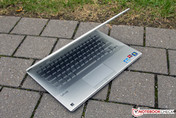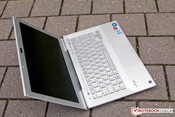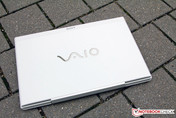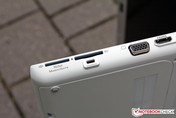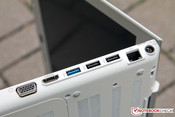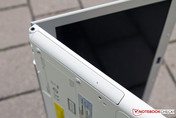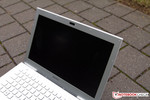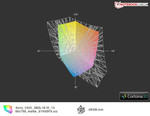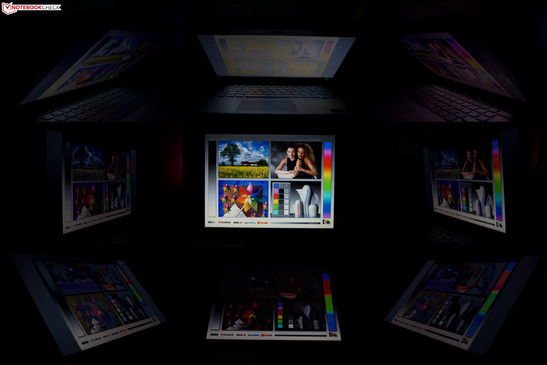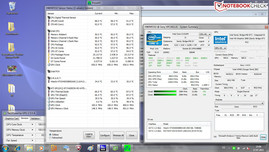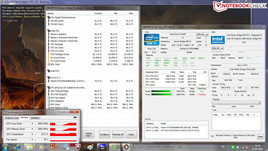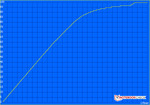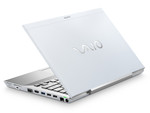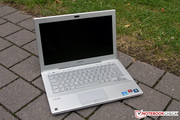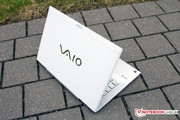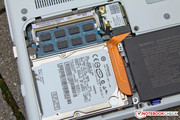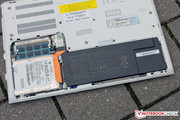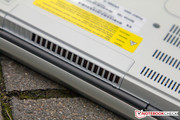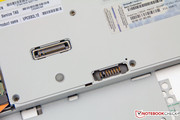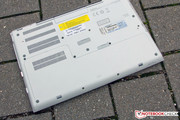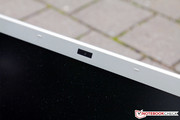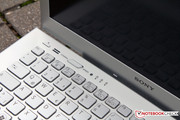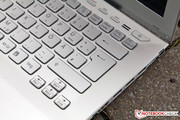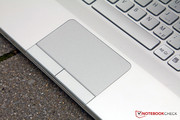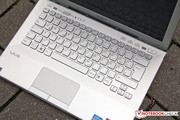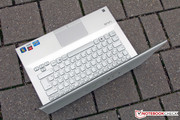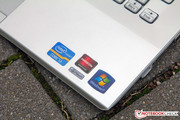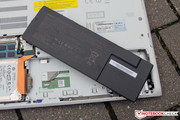Review Sony Vaio VPC-SB2L1E/W Subnotebook
Subnotebooks with a 13.3 inch display are falling more and more in favor and are increasingly also attainable for more moderate prices below 1000 Euros. For this reason Sony has extended the product line of the SB series with the Vaio VPC-SB2L1E/W reviewed by us, which has an Intel Core i3-2310M dual-core processor and a dedicated AMD Radeon HD 6470M graphics card. Depending on personal taste this entry-level device is available in white or silver, whereby the aluminum chassis with its 'full flat' design is the foundation in both cases. In addition further features from the more expensive models remain. Among these is the Vaio Display Plus display with a semi non-reflective display surface and resolution of 1366 x 768 pixels, or the possibility of connecting a docking station and also a battery slice.
For an entry price of 799 Euros (RRP) buyers will however have to make compromises in terms of the RAM (4 GByte), and the hard drive capacity, as well as the mobile internet accessibility (3G UMTS not available). Read whether this purchase is nevertheless worth while, and whether this subnotebook is justified for the targeted student customers. Hot question: What has happened to the weaknesses of its predecessor, the Sony Vaio VPC-SB1Z9EB, which we reviewed several months ago?
Connectivity
The provided connectivity hasn't been reduced, and the distribution of the ports is restricted, with the exception of the headphone output and the DVD drive (optional: Blu-ray; +180 Euros), to the right side of the device. A positive aspect is the fact that the frequently used USB ports (2x USB 2.0, 1x USB 3.0), as well as the HDMI and Ethernet interfaces, are relatively far towards the back. When using an external mouse this position is however still not ideal for positioning the cable when moving the mouse around. Thanks to the integrated docking port this area of criticism isn't too much of a hindrance though. The double card reader for Sony's proprietary memory cards, as well as SD or MMC storage cards, belongs among the usual features of most Vaio notebooks.
The bottom of the case provides access to the most important components. After removing two screws and the maintenance panel, the storage media (height: 9.5 millimeters), a free RAM socket, the exchangeable battery, as well as the WLAN module are accessible. Theoretically use without the battery inserted is not possible - practically swapping the battery can be relatively time consuming due to its location.
Communication
As far as the communication options are concerned the first signs of savings start to emerge. Along with the currently standard Gigabit Ethernet and WLAN 802.11n, the only addition to this is Bluetooth 2.1 +EDR as a short range technology. The current revision 3.0 +HS, as well as a 3G UMTS module, are not available, and remain restricted to more expensive models. An economical possibility for upgrading are comparably affordable USB sticks with the required features.
Security
With a Kensington lock and hard drive shock protection the security features provided are relatively limited.
Accessories
The slim packaging is nicely arranged on the inside, but also only contains the most necessary accessories for use. Along with the device itself there is a 4 cell battery, the AC adapter with a power cable, and printed documentation. Among the usual optional range of accessories, which are provided by Sony for a relatively high price, there are also a docking station (VGP-PRS20), and a battery slice (VGP-BPSC24) with which it is apparently possible to extend the battery life by up to 15 hours. At a price of 130 Euros respectively the costs stay within limits. From a software perspective the pre-installed products from Adobe, which are otherwise rare, caught our attention.
Warranty
Sony grants our reviewed device a mere standard warranty period of 12 months, which is extended to the usual 24 months when registering. The appropriate instructions for this are stuck directly on the packaging of the subnotebook. If desired the device can also be repaired directly on location, whereby this extra with a duration of 36 months costs an additional 270 Euros (VGPE-VPPSL/3).
Display
Expensive or not: Sony has opted for the 13.3 inch display with a diagonal length of 33.9 centimeters, and a resolution of 1366 x 768 pixels with a 16:9 aspect ratio, covered with a semi non-reflective surface for the whole Vaio SB series. Other resolutions or Vaio Display Plus displays are currently not available. On the other hand the VGA and HDMI ports offer the opportunity to connect external displays with higher resolutions. During one of our practical tests both of the interfaces were able to make a good impression using the popular full HD resolution of 1920 x 1080 pixels. With the appropriate device the wireless transmission via Intel Wireless Display (WiDi) is also possible.
The integrated LED backlight of the display is supposed to provide for a slim build of the lid, as well as a bright and even illumination of the display surface. When measuring with the tool Gossen Mavo Monitor this showed that the maximum luminance of 216 cd/m² is only in the broad mid-range of results. The comparable VPC-SB1Z9EB scores significantly better in this respect. One possibility for the variations could be the different product margins (display type). A positive aspect is the even distribution of illumination.
| |||||||||||||||||||||||||
Brightness Distribution: 93 %
Center on Battery: 205 cd/m²
Contrast: 155:1 (Black: 1.32 cd/m²)
42.32% AdobeRGB 1998 (Argyll 3D)
59.8% sRGB (Argyll 3D)
40.66% Display P3 (Argyll 3D)
The additional measured characteristics continue with average values where the luminance leaves off. The black level is elevated with 1.32 cd/m², and doesn't allow for a saturated presentation of blacks. Further to this the display contrast of 155:1 is too low. This should above all be noticeable by movie fans. The subjective color representation of the gradually non-reflective display wasn't able to completely convince us.
Even if the summer is taking its time to come, the display of the SB2 is prepared thanks to its non-reflective surface. Together with the acceptable luminance this results in a good impression when used outdoors. Compared to a matte surface, reflections are not completely prevented, but only restrained. The difference compared to an affordable glare-type display is nevertheless clearly visible.
With respect to professionalism the display isn't able to make a good impression. The sRGB color space is an often used reference for different graphics programs, which is not nearly covered. Sony thus simultaneously manages to create a demarcation point to the devices in the Z series with 13.3 inch displays. Further information on this subject can be found in the reviews of the Sony Vaio VPC-Z13Z9E (high-end), or the Sony Vaio VPC-Z13B7E subnotebooks (entry-level).
Finally, as usual, we are also delving into the viewing angle stability of the display. The horizontal viewing angle stability stays stable up to a deviation of 50 degrees from the front position. Vertically a similar characteristics can be observed, whereby the colors already start to invert or change saturation after 10 degrees. Altogether an average TN display panel, with the advantage of a semi matte surface.
Performance
Current notebooks with a comparatively low entry price are by no means equipped with out of date components. Sony has opted for an Intel Core i3-2310M dual-core processor from the Huron River platform (chipset: HM65) for the 'Studibook" of the SB series. This central component is a favorite entry-level solution and provides a clock speed of 2.1 GHz as well as 3 MBytes of L3 cache. Not considering Hyper-Threading support (4 threads), the missing Turbo-Boost is a negative aspect. The larger dual-core brothers, such as the Intel Core i5-2410M (+50 Euros in configuration), support this useful feature and are usually only marginally more expensive.
Similarly to the display and the processor options, the graphics card doesn't spoil buyers for choice. On the inside is the combination of the integrated Intel GMA HD 3000 processor graphics and the dedicated AMD Radeon HD 6470M from the entry-level segment of the current mid-range. With 512 MBytes of memory and a clock speed of 800 MHz and 900 MHz memory speed, this should also appeal to occasional gamers. What is unfortunate is the fact that Sony has also opted for a manual switching between the graphics units via a sliding controller above the keyboard. Other manufacturers already use the automatic solution PowerXpress 4.0 alias BACON, which is the alternative to Nvidia's Optimus technology. On the other hand the SB2L1E/W has been saved the current teething problems of the AMD solution.
Let's get to our the comprehensive benchmark course. To start off with come the CPU benchmarks from Maxon, during which the Intel Core i3-2310M dual-core processor has to prove itself. Using the tried and tested CineBench R10 calculation with a single thread (single, 64-bit) the processor scores 3469 points, which places it in the mid-range of our database. Next to comparable configurations (e.g. HP ProBook 4530s) the Intel Core i3-380M is ahead on a similar performance level.
During the multi-threading rendering the average performance continues, and devices such as the Acer Aspire 3750 from the Intel TestIT!2011 device pool, or the Dell Inspiron 15R are also in the region of the achieved 7519 points. The identically built Sony Vaio VPC-SB1Z9EB with an Intel Core i5-2520M or the smaller i5-2410M, are faster with 25.8% (10128 points) and 20.4% (9451 points) better performance respectively. In light of the improved performance and the Turbo-Boost 2.0 technology support, we recommend a look at the Intel Core i5-2410M in our opinion, although the tested processor obviously doesn't have any problems with office or multimedia applications.
The synthetic gaming benchmarks from Futuremark give a first indication of the provided 3D performance. In the somewhat older 3DMark06 benchmark the integrated AMD Radeon HD 6470M graphics card scores an acceptable 4421 points. With this score the GPU operates in the lower mid-range, whereby the processor graphics Intel GMA HD 3000 is already almost on a similar performance level. The alternative to the AMD graphics would be the Nvidia GeForce GT 520M graphics solution, whereby this option is also not a guarantee for gaming fun. The next step up from this, which is used by most manufacturers, is the Nvidia's GeForce GT 540M (8196 points, +46.1%). The GPU benchmark from the current 3DMark11 confirms the positioning in the lower third of our database.
| 3DMark 2001SE Standard | 23392 points | |
| 3DMark 03 Standard | 12409 points | |
| 3DMark 05 Standard | 8372 points | |
| 3DMark 06 Standard Score | 4421 points | |
| 3DMark Vantage P Result | 1930 points | |
| 3DMark 11 Performance | 617 points | |
Help | ||
A preliminary verdict is made possible by the system benchmarks. The PCMark Vantage benchmark makes a start in this area as a tried and tested software. With a total result of 4857 points, the components inside the chassis operate in the broad mid-range. Direct neighbors are the Samsung 200B5B Business subnotebook, and the Dell Latitude E5420 Essential with Intel's GMA HD 3000 processor graphics. Higher demands are claimed by the PCMark7 benchmark, whereby the tested device slips into the lower third as a result. On the other hand many older notebooks are completely out of the picture. Altogether the Sony SB2 offers a good performance in the mid-range, with considerable wiggle room above. The Vaio provides sufficient power for office and multimedia use, only when creating content and playing games will the performance reserves quickly become limited.
| PCMark Vantage Result | 4857 points | |
| PCMark 7 Score | 1539 points | |
Help | ||
A lot of bang for the buck is provided by Sony with the included Hitachi Travelstar 5K500.B hard drive type: HTS545050B9SA00. With a rotational speed of 5400 revolutions per minute and SATA II connectivity, this is an ordinarily slow notebook hard drive. The matching benchmarks confirm this assumption with a maximum read speed of 79 MB/s, and an access time of around 21 milliseconds during reading operations. For a fast system operation we would recommend a hybrid-drive (SSH), or a pure Solid State Drive (SSD). Thanks to Intel's Huron River platform modern SATA III drives, such as the Intel SSD Serie 510, OCZ Agility 3, or the Vertex 3, can also be used.
Verdict: Gaming
On the subject of performance: The pure gaming performance is not especially impressive, and is more aimed at occasional gamers without demanding requirements. Simple games, such as World of Warcraft or Fifa 11, run with finer detail settings and higher resolutions. On the other hand there is a lack of performance for newer games, which can only by played with a maximum of medium presets. Altogether this doesn't lead to any gaming fun, and gamers should look for another device with a more potent GPU.
| low | med. | high | ultra | |
|---|---|---|---|---|
| World in Conflict - Benchmark (2007) | 148 | 52 | 23 | 7 |
| Battlefield: Bad Company 2 (2010) | 41.3 | 30.5 | 19.4 | 8.4 |
| StarCraft 2 (2010) | 148.9 | 29.2 | 21.1 | 11.3 |
| Mafia 2 (2010) | 35.8 | 28.1 | 23.4 | 6.8 |
Emissions
System Noise
The rather less than ideal location of the air vent in the area of the display hinge and the cooling system hasn't been changed by Sony. In an idle state the device stays decently subdued in the background, whereby the cooling fan even stays relatively inactive in the Stamina-Mode using the integrated processor graphics, and only a quiet humming from the hard drive can be heard. In an idle state with the AMD graphics in use the cooling fan comes on from time to time, but stays relatively quiet in the background with 31.1 dB(A). Thanks to the slow rotational speed of the hard drive (5400 rpm), as well as the optical drive, these don't stand out negatively.
Under load in the Speed-Mode the cooling fan turns faster and we were able to measure a clearly audible maximum of 48.4 dB(A). Luckily this level is kept consistent during the stress test. On the other hand the perceived noise changes according to the position relative to the cooling fan. When considering similarly constructed notebooks it is noticeable that Apple for example has solved this problem more effectively over the years.
Noise level
| Idle |
| 30.6 / 30.8 / 31.1 dB(A) |
| HDD |
| 31 dB(A) |
| DVD |
| 35 / dB(A) |
| Load |
| 48.1 / 48.4 dB(A) |
 | ||
30 dB silent 40 dB(A) audible 50 dB(A) loud |
||
min: | ||
Temperature
Already in the review of the Sony Vaio VPC-SB1ZEB we were able to recognize problems with the temperature developed inside and on the slim chassis. The new entry-level model continues this trend without any significant improvement. In an idle state the surface temperatures stay in the blue area in the diagram thanks to the aluminum-magnesium case. After several hours of our stress test with the tools Prime95 and Furmark these temperatures increase significantly in some areas. In the area around the cooling system we measured a maximum of 52 degrees Celsius, whereby the average value on the bottom surface lies at a mere 36.6 degrees Celsius. Subjectively the heat generated is clearly noticeable, and longer use on the lap could get unpleasant. Interestingly the entry-level model generates more heat than its predecessor with the previously tested mainstream solution with a more powerful CPU.
(±) The maximum temperature on the upper side is 44.7 °C / 112 F, compared to the average of 35.9 °C / 97 F, ranging from 21.4 to 59 °C for the class Subnotebook.
(-) The bottom heats up to a maximum of 52 °C / 126 F, compared to the average of 39.3 °C / 103 F
(+) In idle usage, the average temperature for the upper side is 28 °C / 82 F, compared to the device average of 30.8 °C / 87 F.
(+) The palmrests and touchpad are reaching skin temperature as a maximum (34.6 °C / 94.3 F) and are therefore not hot.
(-) The average temperature of the palmrest area of similar devices was 28.2 °C / 82.8 F (-6.4 °C / -11.5 F).
On the inside the temperature sensors give a maximum CPU core temperature of 95 (CPU) degrees Celsius, and 87 degrees Celsius in the area of the GPU, during the stress test (100% CPU and GPU load), measured by different programs which thus only act as a point of reference. Despite the stable system operation and the usual GPU frequencies of 800/900 MHz during the stress test, CPU throttling also has a negative impact with this configuration (see screen shots). In extreme cases the combination of Prime95 and Furmark cause throttling with 'Core 1', and a reduced clock speed of 1.9 GHz.
With only Prime95 running, the temperature does reach its limits, but the CPU speed remains at 2.1 GHz. Summary: Throttling is also an issue with this weaker variant, but not as pronounced as it was with more powerful components (SB1Z).
Battery Life
The adopted hardware doesn't have too much reserve performance, and the possibility to switch off the dedicated graphics card, provide for a broad range of power consumption. In an idle state the power consumption lies between 7.3 and 12.9 Watts, whereby the minimum is only possible in the Stamina-Mode. In contrast to this is the power consumption under load with an activated AMD graphics card. At its peak the combination of the dedicated graphics and the stress test (Furmark + Prime95) leads to a power consumption of 60.8 Watts, which is within limits for this configuration though. With a power consumption of 90 Watts, the included AC adapter is sufficient for the requirements.
| Off / Standby | |
| Idle | |
| Load |
|
Key:
min: | |
As a mobile type writer our reviewed device benefits from the economical CPU. Together with the included 4 cell battery (49 Watt-hours), the battery life is a little better in comparison to those from the previously reviewed Sony Vaio VPC-SB1Z9EB. Thus our sample breaks the magical ten hour barrier in an idle state, whereby this scenario (Battery Eater Reader's test, Stamina-Mode) with minimum display brightness doesn't necessarily reflect practical use, but rather represents the positive extreme. Contrary to this is the Classic test (load) with maximum display brightness, activated WLAN module, and dedicated graphics card (Speed-Mode). After a short 79 minutes with this test a whole battery charge is empty.
The practical measurement 'surfing with WLAN' with a pleasant display brightness is a good half-way point. With a battery life of 6 hours and 28 minutes its hard to complain, since it has to be considered that the battery only consists of 4 cells. During this time it shouldn't be difficult to find a power socket at the university or the office for re-charging. For more independence Sony also offers a replacement battery, as well as a battery slice (around 150 Euros), which can be attached to the bottom using a dedicated port.
Verdict
After the review of the Sony Vaio VPC-SB2L1E/W there are a few positive aspects, but also well known disadvantages on our list. The high-quality chassis, the pleasant feel, the backlit keyboard, and the matte 13.3 inch display, make a good impression. The case stability, the average display characteristics, and the persistent problems with the emissions under load, as well as the resulting CPU throttling, are less impressive. For gaming and day-to-day use we were not able to detect any throttling though.
Technically Sony has taken a step back with the configuration reviewed by us, and has opted for current entry-level hardware with manual on/off graphics. Automatically this is certainly more pleasant, but Nvidia clearly has the lead in this area at present. Together with the usual interfaces and the possibility to use a docking station and a battery slice, the subnotebook for students and people with a smaller budget is definitely worth considering. The overall impression and comparison clearly sets this configuration apart from the premium Vaio Z series.




